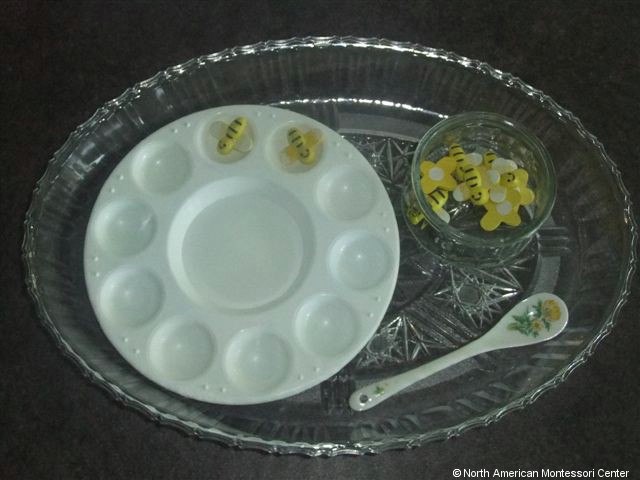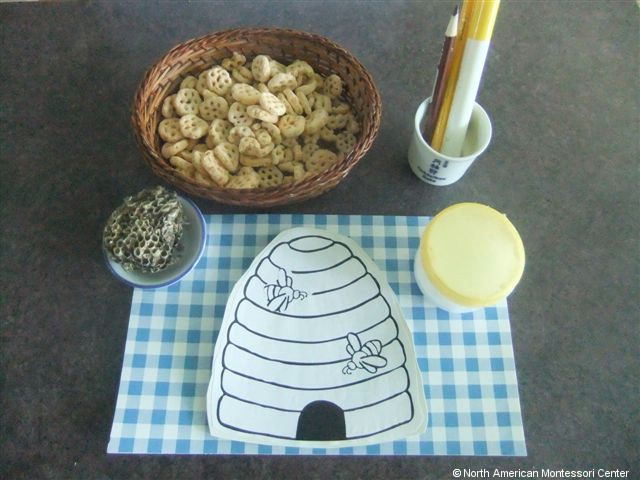
We are now learning about honey bees in our Montessori preschool and discovering what amazing insects they are. We have talked about the parts of a honeybee and learned some big words like “thorax”, “abdomen”, and “antennae”. We were able to look at different flowers with a magnifying class and identify the pistil, the stamens, the calyx and the pollen. The children have also learned that nectar is sucked up through the proboscis (the bee’s tongue), mixed with enzymes in the stomach, and carried back to the hive, where it is stored in wax cells and evaporated into honey.
Studying Honeybees in the Montessori Preschool Classroom: Activity Ideas
We examined a real honeycomb, made several unique bee crafts and explored the bee family. The children learned that the male bees are called “drones” and that they are very lazy bees who live a life of leisure doing no work while being fed by the worker bees (female bees). The children also learned to identify the important queen bee, who lays all of the eggs. Last but not least, there are the hard-working “worker bees” who are always busy. They gather pollen which they stick to their back legs (the pollen basket), and carry it back to the hive where it is used as food. Pollen from the stamens of one flower stick to their bodies, and is carried to another flower where it rubs off onto the pistil, resulting in cross pollination. Mankind's food supply depends greatly on crop pollination by honeybees — amazing!
I have included a few photos to show you all that we've been up to. I hope you enjoy them!

Bee Spooning
A simple Practical Life activity where the children spoon the wooden honey bees (purchased at a dollar store) into a little tray normally used for mixing paints.
Bees in Cornmeal
Another fun Practical Life activity that involves the children hiding the bees in the cornmeal. Once the bees are hidden, they scoop up some cornmeal and gently shake the spoon over the container. The cornmeal falls through the hole and the bee remains in the spoon. The idea is to find all of the hidden honeybees. This was a huge hit!
Beehive Art and Examining a Real Honeycomb
The children had fun coloring the beehive and then glued on pieces of Honeycomb Cereal ... it took a lot of willpower not to sample the cereal but they did it! One of the parents brought in a real honeycomb and it was such a treat to be able to examine the cells with a magnifying glass to see firsthand its intricate structure.
Honeybee Crayon Rubbings:
Crayon rubbing are always fun for the children and very simple to do. The child simply clips a piece of paper over the rubbing plate and then rubs back and forth with the side of a crayon. In a few seconds, the honeybee appears — just like magic!
Making a Bee
This has been another popular activity with the children. Taking the collage tray to their table, they choose 1 black head, 1 yellow body, 1 stinger, 2 googly eyes, 2 wax paper wings and a piece of black paper. The child then glues all of the pieces together, and cuts strips from the black paper to make the stripes. We ended up with a class full of very cute ‘worker bees’!For more bee themed fun and learning, please see part 2.
This year long series looks at the experiences of teachers, parents, students, and Montessori education itself, as we follow a student through his first year at a Montessori Preschool. Montessori Insights and Reflections of a Preschool Child’s First Year is a collection of useful stories, tips, and information that have arisen from one real student's Montessori journey.
As much as possible, NAMC’s web blog reflects the Montessori curriculum as provided in its teacher training programs. We realize and respect that Montessori schools are unique and may vary their schedules and offerings in accordance with the needs of their individual communities. We hope that our readers will find our articles useful and inspiring as a contribution to the global Montessori community.
© North American Montessori Center - originally posted in its entirety at Montessori Teacher Training on Tuesday, June 21, 2011.
© North American Montessori Center - originally posted in its entirety at Montessori Teacher Training on Tuesday, June 21, 2011.

Love all of the activities! Thank you for sharing.
ReplyDeleteYou're more than welcome and I'm pleased to hear that you enjoyed reading about all of the activities. It was definitely a fun theme!
ReplyDelete